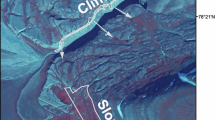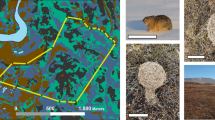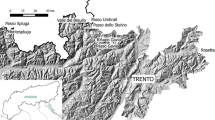Abstract
Despite numerous studies on breeding dispersal, it is still unclear how habitat heterogeneity and previous nesting success interact to determine nest-site fidelity at various spatial scales. In this context, we investigated factors affecting breeding dispersal in greater snow geese (Anser caerulescens atlanticus), an Arctic breeding species nesting in two contrasting habitats (wetlands and mesic tundra) with variable pattern of snowmelt at the time of settlement in spring. From 1994 to 2005, we monitored the nesting success and breeding dispersal of individually marked females. We found that snow geese showed a moderate amount of nest-site fidelity and considerable individual variability in dispersal distance over consecutive nesting attempts. This variability can be partly accounted for by the annual timing of snowmelt. Despite this environmental constraint, habitat differences at the colony level consistently affected nesting success and settlement patterns. Females nesting in wetlands had higher nesting success than those nesting in mesic tundra. Moreover, geese responded adaptively to spatial heterogeneity by showing fidelity to their nesting habitat, independently of snowmelt pattern. From year to year, geese were more likely to move from mesic to high-quality wetland habitat, regardless of previous nesting success and without cost on their subsequent nesting performance. The unpredictability of snowmelt and the low cost of changing site apparently favour breeding-site dispersal although habitat quality promotes fidelity at the scale of habitat patches.


Similar content being viewed by others
References
Anderson MG, Rhymer JM, Rohwer EC (1992) Philopatry, dispersal, and the genetic structure of waterfowl populations. In: Batt BDJ, et al. (eds) Ecology and management of breeding waterfowl. University of Minnesota Press, Minneapolis, Minn., pp 365–395
Badyaev AV, Faust JD (1996) Nest site fidelity in female wild turkey: potential causes and reproductive consequences. Condor 98:589–594
Bennetts RE, Nichols JD, Lebreton J-D, Pradel R, Hines JE, Kitchens WM (2001) Methods for estimating dispersal probabilities and related parameters using marked animals. In: Clobert J, Danchin E, Dhondt AA, Nichols JD (eds) Dispersal. Oxford University Press, Oxford, pp 3–17
Bêty J, Gauthier G, Giroux J-F, Korpimaki E (2001) Are goose nesting success and lemming cycles linked? Interplay between nest density and predators. Oikos 93:388–400
Bêty J, Giroux J-F, Gauthier G (2004) Individual variation in timing of migration: causes and reproductive consequences in greater snow geese (Anser caerulescens atlanticus). Behav Ecol Sociobiol 57:1–8
Blums P, Nichols JD, Lindberg MS, Hines JE, Mednis A (2003) Factors affecting breeding dispersal of European ducks on Engure marsh, Latvia. J Anim Ecol 72:292–307
Boulinier T, Danchin E, Monnat JY, Doutrelant C, Cadiou B (1996) Timing of prospecting and the value of information in a colonial breeding bird. J Avian Biol 27:252–256
Brownie C, Hines JE, Nichols JD, Pollock KH, Hestbeck JB (1993) Capture–recapture studies with multiple strata including non-Markovian transitions. Biometrics 49:1173–1187
Burnham KP, Anderson DR (1998) Model selection and inference: a practical information-theoretic approach. Springer, New York
Cam E, Oro D, Pradel R, Jimenez J (2004) Assessment of hypotheses about dispersal in a long-lived seabird using multistate capture–recapture models. J Anim Ecol 73:723–736
Choquet R, Reboulet A-M, Pradel R, Lebreton JD (2001) U-care (Utilities–CApture–REcapture) user’s guide. In: CEFE/CNRS (ed) Montpellier, France
Clark RG, Shutler D (1999) Avian habitat selection: pattern from process in nest-site use by ducks? Ecology 80:272–287
Clobert J, Danchin E, Dhondt AA, Nichols JD (eds) (2001) Dispersal. Oxford University Press, New York
Cooke F, Abraham KF (1980) Habitat and locality selection in lesser snow geese: the role of previous experience. In: Proceedings of the International Ornithological Congress, vol 17, pp 998–1004
Danchin E, Boulinier T, Massot M (1998) Conspecific reproductive success and breeding habitat selection: implications for the study of coloniality. Ecology 79:2415–2428
Danchin E, Giraldeau LA, Valone TJ, Wagner RH (2004) Public information: from noisy neighbors to cultural evolution. Science 305:487–491
Dinsmore SJ, White GC, Knopf FL (2002) Advanced techniques for modeling avian nest survival. Ecology 83:3476–3488
Doligez B, Danchin E, Clobert J (2002) Public information and breeding habitat selection in a wild bird population. Science 297:1168–1170
Doligez B, Cadet C, Danchin E, Boulinier T (2003) When to use public information for breeding habitat selection? The role of environmental predictability and density dependence. Anim Behav 66:973–988
ESRI (2004) ArcGIS 9.0. In: Environmental Systems Research Institute, Redlands
Fortier D, Allard M (2005) Frost-cracking conditions, Bylot Island, Eastern Canadian Arctic Archipelago. Permafrost Periglac 16:145–161
Fowler AC (2005) Fine-scale spatial structuring in cackling canada geese related to reproductive performance and breeding philopatry. Anim Behav 69:973–981
Gauthier G (1990) Philopatry, nest-site fidelity, and reproductive-performance in Buffleheads. Auk 107:126–132
Gauthier G (1993) Feeding ecology of nesting greater snow geese. J Wildl Manage 57:216–223
Gauthier G, Rochefort L, Reed A (1996) The exploitation of wetland ecosystems by herbivores on Bylot Island. Geosci Can 23:253–259
Greenwood PJ (1980) Mating systems, philopatry and dispersal in birds and mammals. Anim Behav 28:1140–1162
Greenwood PJ, Harvey PH (1982) The natal and breeding dispersal of birds. Annu Rev Ecol Syst 13:1–21
Haeming PD (2001) Symbiotic nesting of birds with formidable animals: a review with applications to biodiversity conservation. Biodivers Conserv 10:527–547
Holt RD, Barfield M (2001) On the relationship between the ideal free distribution and the evolution of dispersal. In: Clobert J, Danchin E, Dhondt AA, Nichols JD (eds) Dispersal. Oxford University Press, Oxford
Hoover JP (2003) Decision rules for site fidelity in a migratory bird, the prothonotary warbler. Ecology 84:416–430
Hughes RJ, Reed A, Gauthier G (1994) Space and habitat use by greater snow goose broods on Bylot Island, Northwest Territories. J Wildl Manage 58:536–545
Johnson DH (1979) Estimating nest success: the Mayfield method and an alternative. Auk 96:651–661
Lebreton JD, Pradel R (2002) Multistate recapture models: modelling incomplete individual histories. J Appl Stat 29:353–369
Lecomte N, Careau V, Gauthier G, Giroux J-F (2007) Habitat labyrinths as refuges from terrestrial predators: spatio-temporal variation of predation risk in arctic-nesting geese. J Anim Ecol (accepted)
Lepage D, Gauthier G, Reed A (1996) Breeding-site infidelity in greater snow geese: a consequence of constraints on laying date? Can J Zool 74:1866–1875
Lepage D, Gauthier G, Menu S (2000) Reproductive consequences of egg-laying decisions in snow geese. J Anim Ecol 69:414–427
Lessells CM (1985) Natal and breeding dispersal of canada geese Branta canadensis. Ibis 127:31–41
Lindberg MS, Sedinger JS, Rexstad EA (1995) Estimating nest site fidelity of adult female black brant with multi-state modeling and geographic information systems. J Appl Stat 22:725–735
MacDonald DW, Johnson DDP (2001) Dispersal in theory and practice: consequences for conservation biology. In: Clobert J, Danchin E, Dhondt AA, Nichols JD (eds) Dispersal. Oxford University Press, Oxford, pp 359–372
Mainguy J, Gauthier G, Giroux JF, Bêty J (2006) Gosling growth and survival in relation to brood movements in greater snow geese (Chen caerulescens atlantica). Auk 123:1077–1089
Massé H, Rochefort L, Gauthier G (2001) Carrying capacity of wetland habitats used by breeding greater snow geese. J Wildl Manage 65:271–281
Menu S, Gauthier G, Reed A (2001) Survival of juvenile greater snow geese immediately after banding. J Field Ornithol 72:282–290
Mowbray TB, Cooke F, Ganter B (2000) Snow goose (Chen caerulescens). In: Poole A, Gill F (eds) The birds of North America, no. 514. The Birds of North America, Philadelphia, Pa.
Pradel R, Wintrebert CMA, Gimenez O (2003) A proposal for a goodness-of-fit test to the Arnason–Schwarz multisite capture–recapture model. Biometrics 59:43–53
Reed A, Hughes RJ, Gauthier G (1995) Incubation behavior and body-mass of female greater snow geese. Condor 97:993–1001
Reed A, Hughes RJ, Boyd H (2002) Patterns of distribution and abundance of greater snow geese on Bylot Island, Nunavut, Canada 1983–1998. Wildfowl 53:53–65
Reed ET, Bêty J, Mainguy J, Gauthier G, Giroux JF (2003) Molt migration in relation to breeding success in greater snow geese. Arctic 56:76–81
Reed ET, Gauthier G, Pradel R (2005) Effects of neck bands on reproduction and survival of female greater snow geese. J Wildl Manage 69:91–100
Rohwer EC, Anderson MG (1988) Female-biased philopatry, monogamy and the timing of pair formation in waterfowl. Curr Ornithol 5:187–221
Ronce O, Oliviery I, Clobert J, Danchin E (2001) Perspectives on the study of dispersal evolution. In: Clobert J, Danchin E, Dhondt AA, Nichols JD (eds) Dispersal. Oxford University Press, Oxford, pp 341–357
SAS I (1989–2001) JMP-IN 4.0. In: Institute S (ed) SAS Institute, Cary, N.C.
Shutler D, Weatherhead PJ (1994) Movement patterns and territory acquisition by male red-winged blackbirds. Can J Zool 72:712–720
Smith SM (1978) The “underworld” in a territorial sparrow: adaptive strategy for floaters. Am Nat 112:571–582
Switzer PV (1993) Site fidelity in predictable and unpredictable habitats. Evol Ecol 7:533–555
Switzer PV (1997) Past reproductive success affects future habitat selection. Behav Ecol Sociobiol 40:307–312
Tremblay JP, Gauthier G, Lepage D, Desrochers A (1997) Factors affecting nesting success in greater snow geese: effects of habitat and association with snowy owls. Wilson Bull 109:449–461
Trexler JC, Travis J (1993) Nontraditional regression analyses. Ecology 74:1629–1637
Valone TJ, Templeton JJ (2002) Public information for the assessment of quality: a widespread social phenomenon. Philos Trans Roy Soc B 357:1549–1557
Van Noordwijk AJ (1995) On bias due to observer distribution in the analysis of data on natal dispersal in birds. J Appl Stat 22:683–694
White GC, Burnham KP (1999) Program MARK: survival estimation from populations of marked animals. Bird Stud 46:120–139
Wiens JA (1989) Spatial scaling in ecology. Funct Ecol 3:385–397
Wiklund CG (1996) Determinants of dispersal in breeding merlins (Falco columbarius). Ecology 77:1920–1927
Acknowledgements
Funding was provided by grants from the Natural Sciences and Engineering Research Council of Canada to G. Gauthier, the Arctic Goose Joint Venture (Canadian Wildlife Service), the Fonds Québécois pour la Recherche sur la Nature et les Technologies (Ministère de l’Éducation du Québec), ArcticNet, and the Northern Ecosystem Initiative (Environment Canada). Université Laval, the Centre d’Études Nordiques, the Société Provancher, the Fonds Richard Bernard and the Department of Indian Affairs and Northern Development provided additional financial assistance to N. Lecomte. Logistic supports were generously provided by the Polar Continental Shelf Project (Natural Resources Canada). We thank all the people who participated in the fieldwork, especially J. Bêty, M.-C. Cadieux, A. Calvert, V. Careau, M.-H. Dickey, M.-A. Giroux, M. Graham-Sauvé, A. Hargreaves, J. Inootik, C. Juillet, J. Mainguy, O. Mathieu, M. Morissette, C. Mussely, N. Ouellet, G. Picard, V. Préfontaine, A. Reed, E. Reed, G. Szor. We are grateful to T. Boulinier, S. Côté, V. Careau, M.-A. Giroux, A. Reed, S. Robinson and R. Rockwell and for their comments on this manuscript and to Heather Bryan for proofreading. We are indebted to the Pond Inlet Hunter and Trapper Association (Nunavut Territory) and to Parks Canada for allowing us to work on Bylot Island. This is Polar Continental Shelf Project contribution no. 017–07.
Author information
Authors and Affiliations
Corresponding author
Additional information
Communicated by Scott Robinson.
Rights and permissions
About this article
Cite this article
Lecomte, N., Gauthier, G. & Giroux, JF. Breeding dispersal in a heterogeneous landscape: the influence of habitat and nesting success in greater snow geese. Oecologia 155, 33–41 (2008). https://doi.org/10.1007/s00442-007-0860-6
Received:
Accepted:
Published:
Issue Date:
DOI: https://doi.org/10.1007/s00442-007-0860-6




